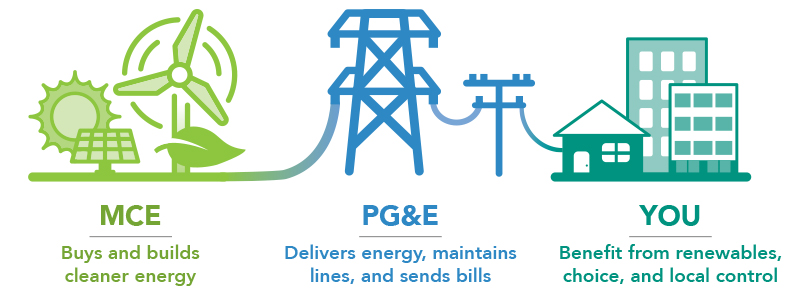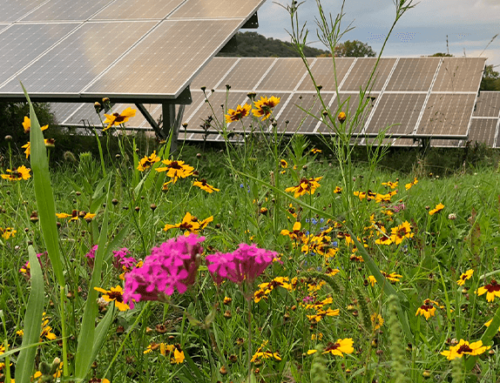If you’re new to MCE, you may have some questions about MCE’s service and what having a community choice option means for you. MCE is not a scam, but rather a not-for-profit public agency that offers communities a choice in where their energy comes from and how their ratepayer dollars are used.
Who is MCE?
MCE is your local, not-for-profit, public electricity provider. We’re what’s known as a Community Choice Aggregator (CCA), also referred to as a community choice energy program. MCE was the first CCA in California, but there are now 24 CCAs serving over 11 million customers in 190+ communities in the state.
MCE has been serving communities in the Bay Area since 2010, and now serves over 480,000 customers in Contra Costa, Marin, Napa, and Solano Counties. Our mission is to address climate change by reducing energy-related greenhouse gas emissions while creating more equitable communities. We do this by offering customers electricity service options with more than twice the amount of renewable energy as a traditional utility service, while providing numerous customer programs and services.
How is MCE regulated?
MCE is regulated by a variety of authorities, including the Federal Energy Regulatory Commission, the California Air Resources Board, the California Energy Commission, the California Public Utilities Commission, the California Independent System Operator, the California Secretary of State, the US Energy Information Administration, and our Board of Directors. MCE’s Board of Directors consists of elected officials from the communities we serve. Each city, town, or county is eligible to appoint a councilmember or supervisor to MCE’s Board to represent their community. MCE’s Board meetings are open to the public and are streamed live so that our customers and stakeholders can weigh in on our decision-making processes. The Board functions the same way as a local government, offering participants the opportunity to present their opinions in public open time that Board members can respond to.
Who controls MCE’s rates?
The MCE Board of Directors sets electric generation rates for our customers. We value public participation and transparency, which is why our rates are developed, discussed, evaluated, and approved at public meetings at our San Rafael and Concord offices. We invite you to attend and give us your feedback. Rate setting typically occurs annually, and new rates are usually approved in April.
How do MCE’s rates compare to PG&E’s rates?
MCE’s electricity generation rates have always been less expensive than PG&E’s electricity generation rates. Total costs to customers also include an exit fee charged by PG&E. When you include this additional fee, MCE has also been less expensive than PG&E 70% of the time. For more information, sample cost comparisons, and cost calculators, visit our rates page.
Part of MCE’s mission is to offer stable and cost-competitive rates. We haven’t raised our rates since 2019 and have no plans to do so in 2021. MCE’s cost comparisons are always kept up to date and available on our website. We have recently adjusted our cost comparison to include a range of costs that customers can expect to see. Customer costs will vary based on when their jurisdiction (i.e., city, town, or county) departed PG&E’s generation service, what electricity rate plan they’re on, and how much electricity they use. MCE’s new cost comparisons more accurately depict this range.
Why are MCE’s generation rates so much lower than PG&E’s rates?
MCE’s generation rates are set by our Board of Directors, taking into consideration the cost of MCE’s energy contracts, funding for MCE’s customer programs, and the financial stability of our reserve fund. MCE’s generation rates have always been lower than PG&E’s rates because MCE began purchasing energy in the market at a time when the cost of power was low.
Over the past decade, renewable energy costs have continued to decrease as efficiencies and economies of scale have improved. MCE purchased energy for our customers during a time when power contracts were less expensive than the energy contracts that PG&E is currently responsible for.
Why are new customers automatically enrolled in MCE?
CCA programs like MCE were enabled through state legislation, Assembly Bill 117, passed in 2002. This legislation requires community choice programs to be an opt-out model. When a city, town, or county joins MCE, all eligible customers in that jurisdiction are automatically enrolled in MCE’s service. Customers must take action to opt out by contacting MCE online or by phone or email. MCE notifies customers of their enrollment through four mailed notices, along with attendance at community events, MCE-hosted community meetings, print and digital ads, and articles or ads in local newspapers and newsletters.
Where does MCE’s power come from?
MCE purchases power in the form of power purchase agreements, like other utilities purchase power. As a not-for-profit government agency, MCE works with project developers to create new renewable energy projects in California and in our service area. MCE has contributed an estimated $1.6 billion to new California renewable energy projects, developed 35 megawatts of new renewable energy in our service area, and supported over 5,000 jobs.
MCE’s most recent Power Content Label (2019) shows MCE’s power breakdown compared to the state’s breakdown. MCE’s Light Green service option was 60% renewable and 90% greenhouse gas free, and our Deep Green and Local Sol services remain 100% renewable. Deep Green is sourced from 100% wind and solar energy, whereas Local Sol is sourced from a solar project located in Novato, California.
MCE’s power content is reported to and certified by the California Energy Commission on an annual basis. Because MCE is an electric service provider, our power contracts and reporting are subject to the same requirements and standards as PG&E. Our greenhouse gas reporting and power purchasing are conducted in accordance with state law.
Does MCE use RECs?
Renewable energy certificates (RECs) are accounting mechanisms used to track renewable energy production and provide proof that electricity has been generated from an eligible renewable energy resource and delivered to the electric grid. One REC represents one megawatt-hour (MWh) of renewable energy. This system allows utilities to document their progress toward sustainability goals, such as fulfilling the requirements of California’s Renewables Portfolio Standard program.
REC most commonly refers to category 3, or “unbundled RECs.” Unbundled RECs are associated with renewable energy that’s generated within the Western Electricity Coordinating Council but that aren’t attached to any physical energy. This category of REC allows businesses, organizations, and institutions to claim the environmental benefits of renewable energy generation to help satisfy the sustainability goals or requirements assigned by their local, state, or federal government. Since 2019, MCE hasn’t used any unbundled RECs.
How is my energy content different if I share energy lines with PG&E customers?
MCE delivers a minimum of 60% renewable energy into the electric grid on behalf of our customers. While it’s impossible to track the exact source of energy once it’s on the grid, MCE’s power purchases are verified by the California Independent System Operator and reported to and certified by the California Energy Commission. Other California utilities, such as PG&E, use this standard for verification purposes. By choosing MCE service, customers are investing in cleaning the entire electric grid and supporting community energy programs that provide local economic and workforce benefits. MCE has built 35 megawatts of renewable energy in our service area. The type of power that makes it into your specific home comes from the generation sources closest to you.
Why am I seeing MCE charges on my PG&E bill?
MCE is an alternative electric service provider that offers our customers access to more renewable energy compared to traditional electricity service. MCE’s electric generation charges replace the charges you previously paid PG&E. PG&E continues to provide your gas services, electric delivery, billing, and power line maintenance. PG&E and MCE are working together to provide your electric service, and your bill will include charges from both PG&E and MCE. Visit our bill page to learn more about your energy bill.

Does MCE offer discount programs?
Customers on discount programs, including CARE, FERA, and Medical Baseline, are also automatically enrolled in MCE’s service. Because CARE and other discount programs are state programs, your discount remains in effect. When you reapply, you do so as you normally would, through PG&E. MCE also offers a variety of customer programs to help you save money and access clean energy, along with a COVID resources page for residential and small business customers.
What is the benefit of choosing MCE?
Choosing to be an MCE customer means having access to more renewable electricity and greater control over your service options. It also means that you’re supporting local economic and workforce benefits. MCE is a not-for-profit public agency that focuses on providing renewable energy and a variety of customer programs and benefits. We differ from PG&E because we don’t have shareholders and we can reinvest in our communities. To date we have reinvested an estimated $180 million. To learn more about MCE’s impact and community reinvestment, check out our 2020 Impact Report.
Do organizations like MCE help protect residents against events like the Texas power crisis?
The California electricity market is different than the Texas market. MCE and other electric service providers have strict power purchasing guidelines that help avoid outages like what Texas experienced. Moreover, MCE’s rates are set by our Board of Directors in public meetings. MCE and California customers aren’t exposed to market fluctuations in energy prices due to these set rates. For more information on how California and Texas energy markets differ, we encourage you to read this op-ed from MCE’s Chief Operating Officer.
Do MCE representatives go door-to-door?
No, MCE does not go door-to-door to contact customers. We will not approach you at your private residence to offer information on our services and we do not install equipment or check your meter. MCE is present in your community by attending meetings of local groups and organizations, and hosting booths at local events. If someone has come to your home saying they represent MCE, it is likely a scam; please notify us at 1 (888) 632-3674 or info@mceCleanEnergy.org.
MCE works diligently to make sure our customers’ voices are heard. If you have questions, reach out to our team at info@mceCleanEnergy.org.







